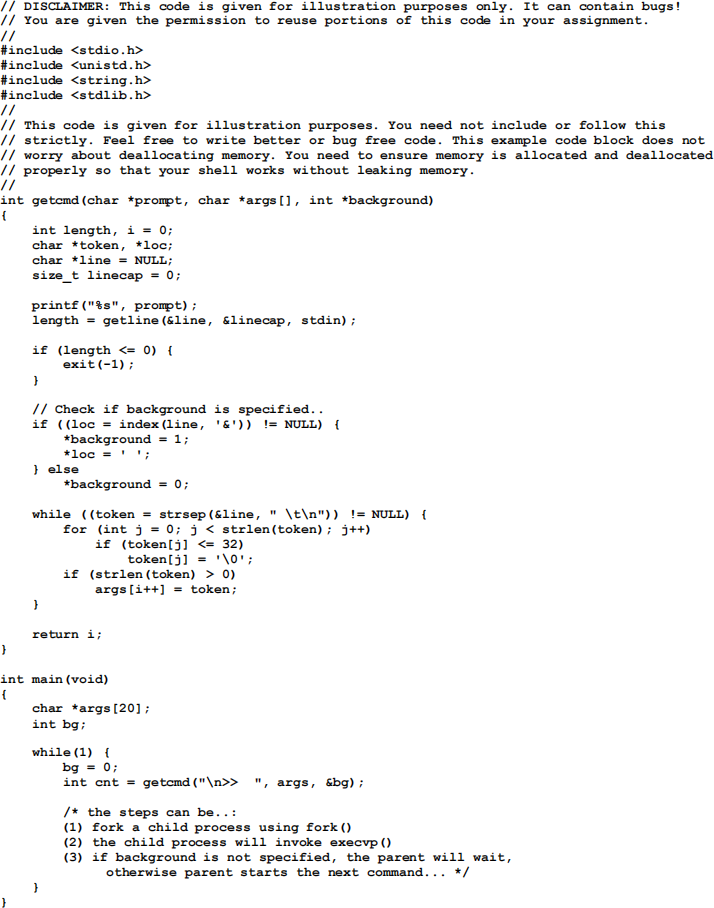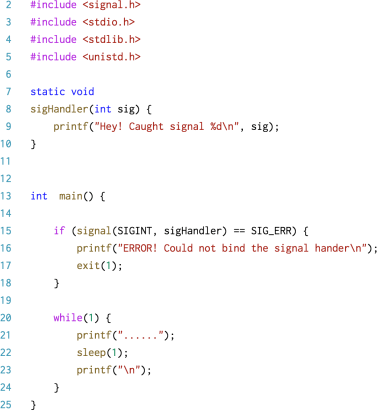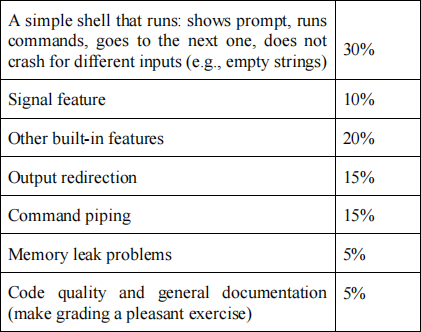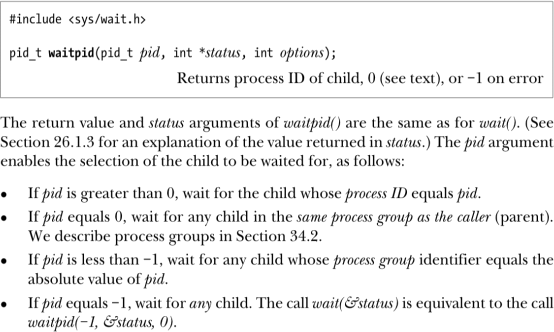Programming Assignment #1: A Simple Shell
Hello, dear friend, you can consult us at any time if you have any questions, add WeChat: daixieit
Programming Assignment #1: A Simple Shell
IMPORTANT: You are NOT allowed to include code from any other sources (except the sample code given in this handout). If someone else turns in a copy of your code, your assignment will be flagged as a copy as well. All students with the same copy will be reported to the disciplinary officer. You can discuss problems arising in the design and implementation without sharing code. The code you submit should be written by you only.
In this assignment you are required to create a C program that implements a shell interface that accepts user commands and executes each command in a separate process. Your shell program provides a command prompt, where the user inputs a line of command. The shell is responsible for executing the command. The shell program assumes that the first string of the line gives the name of the executable file. The remaining strings in the line are considered as arguments for the command. Consider the following example.
sh > cat prog.c
The cat is the command that is executed with prog.c as its argument. Using this command, the user displays the contents of the file prog.c on the display terminal. If the file prog.c is not present, the cat program displays an appropriate error message. The shell is not responsible for such error checking. In this case, the shell is relying on cat to report the error.
One technique for implementing a shell interface is to have the parent process first read what the user enters on the command line (i.e., cat prog.c), and then create a separate child process that performs the command. Unless specified otherwise, the parent process waits for the child to exit before continuing. However, UNIX shells typically also allow the child process to run in the background – or concurrently – as well by specifying the ampersand (&) at the end of the command. By re-entering the above command as follows the parent and child processes can run concurrently.
sh > cat prog.c &
Remember that parent is the shell process and child is the process that is running cat. Therefore, when the parent and child run concurrently because the command line ends with an &, we have the shell running before the cat completes. So, the shell can take the next input command from the user while cat is still running. As discussed in the lectures, the child process is created using the fork() system call and the user’s command is executed by using one of the system calls in the exec() family (see man exec for more information).
Simple Shell
A C program that provides the basic operations of a command line shell is supplied below for illustration purposes. This program is composed of two functions: main() and getcmd(). The getcmd() function reads in the user’s next command, and then parses it into separate tokens that are used to fill the argument vector for the command to be executed. If the command is to be run in the background, it will end with ‘&’, and getcmd() will update the background parameter so the main() function can act accordingly. The program terminates when the user enters <Control><D> because getcmd() invokes exit().
The main() calls getcmd(), which waits for the user to enter a command. The contents of the command entered by the user are loaded into the args array. For example, if the user enters ls –l at the command prompt, args[0] is set equal to the string “ls” and args[1] is set to the string to “–l”. (By “string,” we mean a null-terminated C-style string variable.)
This programming assignment is organized into three parts: (1) creating the child process and executing the command in the child, (2) signal handling feature, and (3) additional features.
Creating a Child Process
The first part of this programming assignment is to modify the main() function in the figure below so that upon returning from getcmd() a child process is forked and it executes the command specified by the user.

As noted above, the getcmd() function loads the contents of the args array with the command line given by the user. This args array will be passed to the execvp() function, which has the following interface:
execvp(char *command, char *params[]);
Where command represents the file to be executed and params store the parameters to be supplied to this command. Be sure to check the value of background to determine if the parent process should wait for the child to exit or not. You can use the waitpid() function to make the parent wait on the newly created child process. Check the man page for the actual usage of the waitpid() or similar functions that you can use.
Signal Handling Feature
The next task is to modify the above program so that it provides a signal handling feature. You can think of the signals as software interrupts. The signals are sent to a process because of external events such as keyboard presses (pressing the Ctrl + C key), external programs sending signals with specific values, or abnormal conditions created by the program (segmentation faults). A process is wired to act in a default way on the receipt of a given signal. You can change this default behaviour using a system call. The figure below shows how a program reacts to a delivery of a signal assuming the program is programmed to anticipate the arrival of the signal.

You need to develop a signal feature that would do the following: (a) kill a program running inside the shell when Ctrl+C (SIGINT) is pressed in the keyboard and (b) ignore the Ctrl+Z (SIGTSTP) signal. That is for SIGINT you kill the process that is running within the shell. For Ctrl+Z, you just ignore it so that your shell would not react to it using the default action.
There are two ways to setup signal handlers. We would use the legacy interface because it is easy to understand. For portable programs, the approach is not recommended because it works differently on different Unix/Linux implementations. The general approach is very simple. You create a function for handling a particular signal and hookup the function to act as the signal handler using the signal() system call. The following example program should give you the general idea.

Built-in Commands
A command is considered built-in, when all the functionality is completely built into the shell (i.e., without relying on an external program). The main feature of the shell discussed in the first two sections of this handout is about forking a child process to run external commands. Now, we want to implement the following built-in commands: cd (change directory), pwd (present working directory), exit (leave shell), fg (foreground a background job), and jobs (list background jobs). The cd command could be implemented using the chdir() system call, the pwd could be implemented using the getcwd() library routine, and the exit command is necessary to quit the shell. The fg command should be called with a number (e.g., fg 3) and it will pick the job numbered 3 (assuming it exists) and put it into the foreground. The command jobs should list all the jobs that are running in the background at any given time. These are jobs that are put into the background by giving the command with & as the last one in the command line. Each line in the list provided by the jobs should have a number identifier that can be used by the fg command to bring the job to the foreground (as explained above).
cd command: This command takes a single argument that is string. It changes into that directory. You are basically calling the chdir() system call with the string that is passed in as the argument. You can optionally print the current directory (present working directory) if there are no arguments. You don’t need to support additional features (e.g., those found in production shells like bash).
pwd command: This command takes no argument. It prints the present working directory.
exit command: This command takes no argument. It terminates the shell. It will terminate any jobs that are running in the background before terminating the shell.
fg command: This command takes an optional integer parameter as argument. It brings the background job to the foreground. The background can contain many jobs you could have started with the & at the end.
jobs command: This command takes no argument. It lists all the jobs that are running in the background.
Simple Output Redirection
The next feature to implement is the output redirection. If you type
ls > out.txt
The output of the ls command should be sent to the out.txt file. See the class notes on how to implement this feature.
Simple Command Piping
The last feature to implement is a simplified command piping. If you type
ls | wc -l
The output of the ls command should be sent to the wc –l command. One easy way of implementing this command piping is to write the output of ls to the disk and ask the second command to read the input from the disk. However, in this assignment and in the real system, you don’t implement it through the file system. You implement command piping using an inter-process communication mechanism called pipes (anonymous). You can follow our discussion in the class and it should implement a command piping that should work with the above example.
Turn-in and Marking Scheme
The programming assignment should be submitted via My Courses. Other submissions (including email) are not acceptable. Your programming assignment should compile and run in Linux. Otherwise, the TAs can refuse to grade them. Here the mark distribution for the different components of the assignment.

Useful Information for the Assignment
You need to know how process management is performed in Linux/Unix to complete this assignment. Here is a brief overview of the important actions.
(a) Process creation: The fork() system call allows a process to create a new process (child of the creating process). The new process is an exact copy of the parent with a new process ID and its own process control block. The name “fork” comes from the idea that parent process is dividing to yield two copies of itself. The newly created child is initially running the exact same program as the parent – which is pretty useless. So we use the execvp() system call to change the program that is associated with the newly created child process.
(b) The exit() system call terminates a process and makes all resources available for subsequent reallocation by the kernel. The exit(status) provides status as an integer to denote the exiting condition. The parent could use waitpid() system call to retrieve the status returned by the child and also wait for it.
(c) The pipe() creation system call.
(d) File descriptor duplication system call (dup()).
2021-10-07
